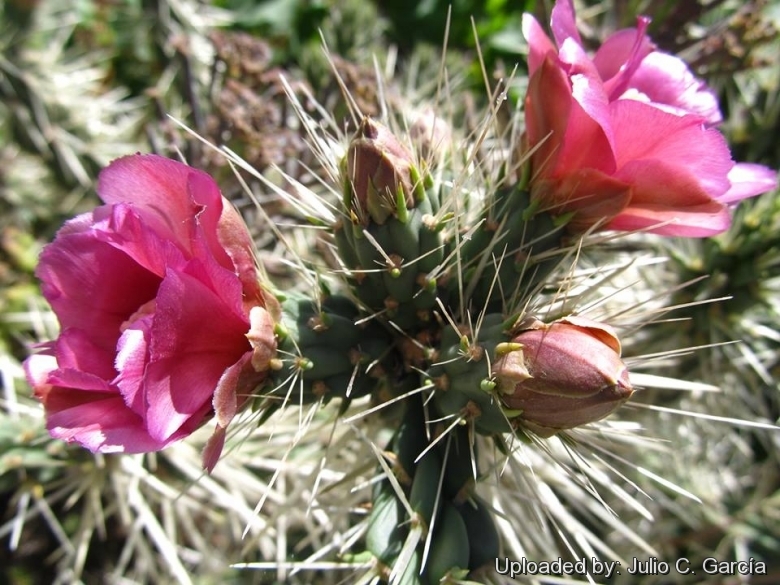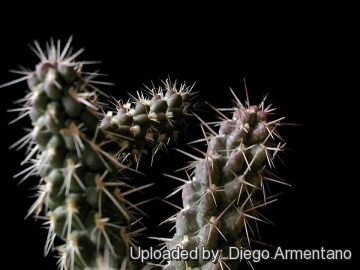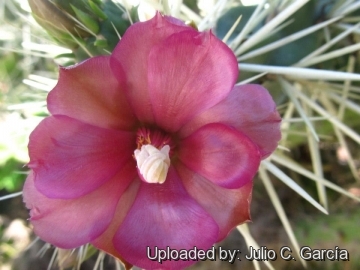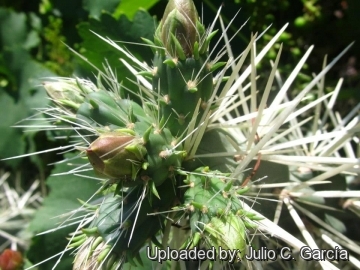Accepted Scientific Name: Cylindropuntia rosea (DC.) Backeb.
Cactaceae (Backeberg) 1: 197 1958 Backeb.

Opuntia rosea (Cylindropuntia rosea) Photo by: Julio C. García
Origin and Habitat: Hidalgo, Mexico, Puebla, and Tlaxcala, Mexico.
Habitat and Ecology: Cylindropuntia roseaSN|28379]]SN|28379]] occurs in xerophyllous scrub and prefers disturbed habitat and calcareous soils. This species (like most Cylindropuntia) spread via movement of detachable stems that are capable to form roots when they come in contact with the ground. The population size and trend of the species is unknown. The threats to this species are unknown.
Synonyms:
See all synonyms of Cylindropuntia rosea
back
Accepted name in llifle Database:Cylindropuntia rosea (DC.) Backeb.Cactaceae (Backeberg) 1: 197 1958Synonymy: 6
back
Common Names include:
ENGLISH: Rosea cactus, Tree cactus, Walkingstick cholla, Cane cactus, Candelabrum cactus, Chain-link cactus, Coyote candles, Cane cholla
AFRIKAANS (Afrikaans): Roseakaktus
SPANISH (Español): Joconostli (Mexico), Xoconostle (Mexico), Abrojo, Cardon, Entrena, Velas de coyote, Vela de coyote, Tasajo, Coyonostole (Mexico), Coyonoxtle (Mexico), Coyonostli (Mexico), Coyonostle (Mexico), Cholla, Cardo, Cardenche
Description: Cylindropuntia roseaSN|28379]]SN|28379]] is a very spiny shrubby cactus, branching basally with ascending stems, 20-50 cm high. The long and very sharp spines posses a characteristic papery detachable sheath. There is uncertainty about the validity of this species. It could be both Cylindropuntia imbricataSN|28383]]SN|8156]] (Haw) Knuth or a form of Cylindropuntia tunicataSN|28226]]SN|28226]] (Lehm) Knuth with a different flower colour which is deep pink, this form is described by Rose as Cylindropuntia pallidaSN|8156]]SN|28383]] (Rose) Knuth .
Stem segments: Cylindrical, growing end to end, greygreen, 10-15 cm long, 1.6-2.5 cm in diameter, with distinct tubercles.
Areoles: Large, 2-3.5 cm apart.
Leaves: Thin subulate, caducous.
Glochids: Yellow, 2-5 mm long.
Spines: 4-9, sometimes only one, needle-like, yellow to reddish to grey, 1-4 cm long. Sheaths papery, yellowish, not completely covering the spines.
Flowers: Cylindropuntia roseaSN|28379]]SN|28379]] is not a reliable bloomer. When flowering finally occurs, the flowers will be a beautiful rose colour up to 3.8-4 cm long. The flowers are developed always at the top of the stems.
Blooming season (in habitat): It flowers in summer between June and July.
Fruits: Obconical to obovoid, yellow, spiny, 1.6-1.8 cm long, 1.1-1.4 cm in diameter, with distinct tubercles. The fruit have been regarded as not producing seeds at all, but recent studies discovered fruits containing seed.
Notes: The Cylindropuntia (the cylindrical Opuntias of North-America) can easily be distinguished from Austrocylindropuntia (the cylindrical Opuntias of South-America) Austrocylindropuntia by their spines having a papery sheaths (Austrocylindropuntia spines lack them). Moreover Austrocylindropuntia have cylindrical stems that grow indeterminately, while Cylindropuntia has stems that grow in a single season. The seeds are different too.
Bibliography: Major references and further lectures.
1) A. Michael Powell, James F. Weedin “Cacti of the Trans-Pecos & Adjacent Areas” Texas Tech University Press, 2004
2) Edward Anderson “The Cactus family” Timber Press, Incorporated, 2001
3) James Cullen, Sabina G. Knees, H. Suzanne Cubey "The European Garden Flora Flowering Plants: A Manual for the Identification of Plants Cultivated in Europe, Both Out-of-Doors and Under Glass" Cambridge University Press, 11/Aug/2011
4) David R Hunt; Nigel P Taylor; Graham Charles; International Cactaceae Systematics Group. "The New Cactus Lexicon" dh books, 2006
5) Ulises Guzmán, Salvador Arias, Patricia Dávila, “Catálogo de cactáceas mexicanas” Universidad Nacional Autónoma de México, Mexico 2003, p.114.
6) Urs Eggli, Leonard E. Newton: “Etymological Dictionary of Succulent Plant Names” Birkhäuser 2004
7) Arias, S. & Hernández, H.M. 2013. Cylindropuntia rosea. The IUCN Red List of Threatened Species. Version 2014.2. <www.iucnredlist.org>. Downloaded on 12 August 2014.
8) Jim Cullen, Mic Julien, Rachel McFadyen “Biological Control of Weeds in Australia” Csiro Publishing, 05/Mar/2012
 Opuntia rosea (Cylindropuntia rosea) Photo by: Julio C. García
Opuntia rosea (Cylindropuntia rosea) Photo by: Julio C. García Opuntia rosea (Cylindropuntia rosea) Photo by: Diego Armentano
Opuntia rosea (Cylindropuntia rosea) Photo by: Diego Armentano Opuntia rosea (Cylindropuntia rosea) Photo by: Julio C. García
Opuntia rosea (Cylindropuntia rosea) Photo by: Julio C. García Opuntia rosea (Cylindropuntia rosea) Photo by: Julio C. García
Opuntia rosea (Cylindropuntia rosea) Photo by: Julio C. García Opuntia rosea (Cylindropuntia rosea) Photo by: Julio C. García
Opuntia rosea (Cylindropuntia rosea) Photo by: Julio C. GarcíaSend a photo of this plant.The gallery now contains thousands of pictures, however it is possible to do even more. We are, of course, seeking photos of species not yet shown in the gallery but not only that, we are also looking for better pictures than those already present.
Read More... Cultivation and Propagation: Cylindropuntia roseaSN|28379]]SN|28379]] is a a much decorative hardy cactus easily found in cultivation. It is a summer grower species that offers no cultivation difficulties. Its cylindrical densely spiny joints provide a striking accent for an otherwise dormant cactus garden.
Soil: Use a very a particularly draining substratum, as it is sensitive to rottenness when in presence of humidity and low temperatures and let the soil dry out between waterings, since it's natural habitat is in sandy or gravelly, well draining soils.
Repotting: Repot in the spring, when their roots become cramped. Generally, they should be repotted every other year in order to provide fresh soil. After repotting, do not water for a week or more.
Water: In summer, during the vegetative period, it must be regularly watered, but allowing the substratum to completely dry up before irrigating again (but do not overwater ); in winter, it’s to be kept dry. Preferable not to water on overcast days, humid days or cold winter days.
Hardiness: It is a quite frost resistant cactus, hardy to -7° C (- 12° C or less if very dry). However in cultivation it is better not to expose it to temperatures lower than -0° C, even if in an aerated and protected location, in order to avoid the formation of anti-aesthetic spots on the epidermis. In presence of high atmospheric humidity avoid any frost as it is particularly sensitive to root rot. USDA Zone 7-10. It can handle extremely high temperatures in summer.
Exposure: Outside full sun or afternoon shade, inside needs bright light, and some direct sun.
Use: It is suitable for “desert” gardens, in association with other xerophytes. Where the open air cultivation is not possible due to the climate, it is to be cultivated in pot in order to shelter it in winter.
Warning: It is armed with treacherous spines that are extremely sharp (This is one of the most dangerous of all cactus). Handle it with extreme caution, and keep it away from gangways and areas frequented by children and animals. Spines must be meticulously removed with tweezers.
Propagation: Stem division. Prickly pear pads root easily and grow rapidly when placed in loose, well-draining soil.















